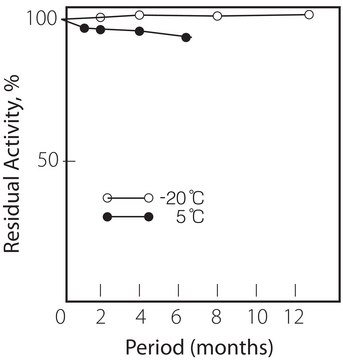MAK207
Glycerol-3-Phosphate Assay Kit
Sufficient for 100 Colorimetric tests
Synonym(s):
G3P Assay Kit
Sign Into View Organizational & Contract Pricing
All Photos(2)
About This Item
Recommended Products
detection method
colorimetric
relevant disease(s)
gastrointestinal diseases
storage temp.
−20°C
General description
Glycerol 3-phosphate (G3P) is an important intermediate of carbohydrate and lipid metabolic pathways. It is produced from glycerol by glycerol kinase or from dihydroxyacetone phosphate by glycerol 3-phosphate dehydrogenase. G3P may enter the G3P shuttle to generate NAD+, or may be converted to glyceraldehyde 3-phosphate and enter glycolysis or the lipid biosynthesis pathway.
Application
Glycerol-3-Phosphate Assay Kit has been used in the determination of glycerol-3-phosphate and phosphoenolpyruvate levels. It has also been used to quantify the concentration in aerial mycelium.
Suitability
Suitable for the detection of Glycerol-3-Phosphate in tissue and cell culture samples.
Principle
The Glycerol 3-Phosphate Colorimetric Assay Kit provides a simple assay for measuring G3P in various tissues and cells (ranging from 2-10 nmole/well). G3P is determined by measuring a colorimetric product with absorbance at 450 nm (A450) proportional to the amount of G3P present.
Kit Components Only
Product No.
Description
- G3P Assay Buffer
- G3P Enzyme Mix
- G3P Probe
- G3P Standard
replaced by
Product No.
Description
Pricing
Signal Word
Danger
Hazard Statements
Precautionary Statements
Hazard Classifications
Eye Dam. 1 - Resp. Sens. 1 - Skin Corr. 1B
Storage Class Code
8A - Combustible corrosive hazardous materials
Regulatory Information
动植物源性产品
Choose from one of the most recent versions:
Certificates of Analysis (COA)
Lot/Batch Number
Don't see the Right Version?
If you require a particular version, you can look up a specific certificate by the Lot or Batch number.
Already Own This Product?
Find documentation for the products that you have recently purchased in the Document Library.
Yongkai Shi et al.
Frontiers in plant science, 9, 687-687 (2018-06-08)
The glycerol-3-phosphate (G-3-P) shuttle is an important pathway for delivery of cytosolic reducing equivalents into mitochondrial oxidative phosphorylation, and plays essential physiological roles in yeast, plants, and animals. However, its role has been unclear in filamentous and pathogenic fungi. Here
Blocking mitochondrial pyruvate import in brown adipocytes induces energy wasting via lipid cycling.
Michaela Veliova et al.
EMBO reports, 21(12), e49634-e49634 (2020-12-05)
Combined fatty acid esterification and lipolysis, termed lipid cycling, is an ATP-consuming process that contributes to energy expenditure. Therefore, interventions that stimulate energy expenditure through lipid cycling are of great interest. Here we find that pharmacological and genetic inhibition of
Alejandro Cabezas-Cruz et al.
Frontiers in cellular and infection microbiology, 7, 375-375 (2017-09-02)
The obligate intracellular pathogen, Anaplasma phagocytophilum, is the causative agent of life-threatening diseases in humans and animals. A. phagocytophilum is an emerging tick-borne pathogen in the United States, Europe, Africa and Asia, with increasing numbers of infected people and animals
Agustín Hidalgo-Gutiérrez et al.
Biomedicines, 9(10) (2021-10-24)
Primary mitochondrial diseases are caused by mutations in mitochondrial or nuclear genes, leading to the abnormal function of specific mitochondrial pathways. Mitochondrial dysfunction is also a secondary event in more common pathophysiological conditions, such as obesity and metabolic syndrome. In
Laura Di Magno et al.
Cell reports, 30(6), 1735-1752 (2020-02-13)
The antidiabetic drug phenformin displays potent anticancer activity in different tumors, but its mechanism of action remains elusive. Using Shh medulloblastoma as model, we show here that at clinically relevant concentrations, phenformin elicits a significant therapeutic effect through a redox-dependent
Our team of scientists has experience in all areas of research including Life Science, Material Science, Chemical Synthesis, Chromatography, Analytical and many others.
Contact Technical Service



